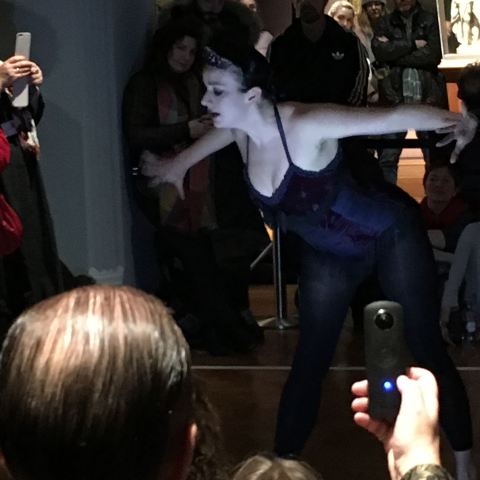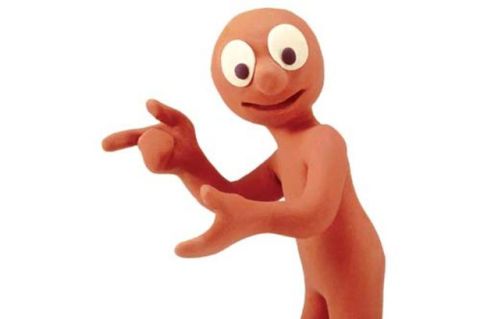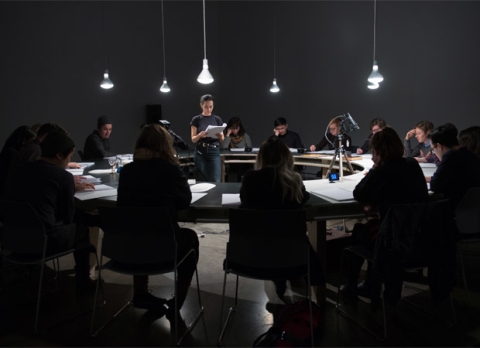Archive for the ‘museums’ Category
Phucket List
I’ve always winced at the phrase ‘Bucket List’ – it smacks of inauthenticity. There was an awful looking movie about a decade ago which I avoided, much though I like Jack Nicholson and Rob Reiner. I think that may have done much to mainstream the concept but I’ve no idea where it originates from or how far back it goes.
Last night I went to the Late Shift Extra at the National Portrait Gallery to hang out at Everything You Can Imagine Is Real. The NPG was a favourite in teenage years as it gave a face to much of the literature and history I was learning about. In recent years I’ve done some pro bono consultancy on the Gallery’s digital strategy. And me and the Mrs go every year to the BP Portrait Award exhibition. Even if I wasn’t such a long-term fan, I love galleries and museums after dark – there’s something slightly naughty about it.
As I came in to the Gallery yesterday evening I bumped into Martyn Ware of Illustrious, Heaven 17, Human League and BEF. We had a chat about the future of energy and Port Merrion and stuff. I know Martyn a bit from the early days of BAFTA Interactive. He curated the Everything You Can Imagine Is Real evening to complement the Picasso portraits exhibition currently showing at the NPG.
“Everything you can imagine is real.”
- Pablo Picasso
I like the quote for giving equal value to the outer and inner world; for putting conscious thought, the dreamed, the imagined and the unconscious on a level playing field.
Some of the playing I most enjoyed last night was a short performance by dancer Vanessa Fenton to Martyn’s reworking of Parade by Eric Satie. I listen to Satie often when I’m writing as his work features on my Music To Write To playlist.
Parade was a ballet by Satie for Diaghilev’s Ballets Russes in 1917 on which he collaborated with Cocteau (scenario), Massine (choreography) and Picasso (sets). Vanessa’s costume by Bruce French in midnight blue and deep-sea green was redolent of the era.

Vanessa Fenton parading her stuff

Where two corridors intersect in the National Portrait Gallery

Martyn Ware records the action

Spirit of Diaghilev

Ware’s Satie?

I also enjoyed a performance by the Radiophonic Workshop, famous scion of the BBC, forever associated with the Dr Who theme tune, and no doubt a significant influence on Martyn and his electro-pop pioneers in Sheffield. They premiered a new composition with visuals derived by Obsrvtry from Picasso. In the middle of it the theremin, that quintessential early electronic instrument, which had been sitting tantalisingly towards the front of the stage, went into action. The previous act, White Noise, had deployed some electronic glove instrument through which hand gestures shaped the sounds but the Theremin is the real shit. It was created by Russian Leon Theremin in 1920 and graced movie soundtracks from Hitchcock’s Spellbound (with its Surreal visuals by another Spanish painter, Salvador Dali) to The Day The Earth Stood Still (a precursor of this year’s Arrival).
Anyway, it prompted me to start my Phuket List here, to be completed over time:
1 Play a Theremin
2 Spend a month painting abroad
3 Go fishing in a Spanish river like in The Sun Also Rises
4 Walk around the Antrim coast
5
6
7
8
9
10
11
12
Any suggestions for 5 – 12 gratefully received…
Picture of the Month: E for Enigma – A Bar at the Folies-Bergère
The most striking thing for me about Un bar aux Folies-Bergère, the last masterpiece by Édouard Manet, painted in 1882 for exhibition at that year’s Paris Salon, are the green booties. What on earth are they doing up there? What kind of night club were they running? Some wild place that they’ve got trapeze artists flying about overhead and no-one gives a monkey’s – no-one is even bothering to look up at them. Circus Circus 90 years ahead of its time. That pair of bright green booties top left and the pink leggings – some kind of surreal joke on the part of M. Manet? Always gets a wry smile out of me. You can see this painting in the Courtauld Collection in London’s Somerset House, London.
I’m currently reading Somerset Maugham’s The Razor’s Edge (appears on a lot of people’s Books That Changed My Life list so thought I’d give it a bash) which includes a scene of a visit to the Folies in post-Global Economic Meltdown Europe i.e. the early 30s . It’s in the context of a bit of a night crawl where a bunch of posh folk trawl the nighttown for thrills from the rough. The sense of classes colliding is strong in this picture, questions of power balance looming large.
Looking and not looking seems to be a preoccupation of Manet. The barmaid stares straight out at you the viewer – the last of a long line of such enigmatic stares. Olympia gives a challenging enigmatic stare in the eponymous painting [below]. As does that cheeky naked picnicker in Manet’s Dejeuner sur l’Herbe [below] (a quick tribute here to recently, dearly departed Malcolm [McLaren] who had fun with Manet’s woman in his Bow Wow Wow period). Manet gets his female protagonists to give as good as they get from staring males, no matter how much at a disadvantage they are (e.g. a bit light on the clothes front).
Now in this picture, Manet puts us, by a bit of mirror jiggery-pokery, in the position of said staring male. You, evidently, are that moustachioed, top-hatted, red-nosed chap reflected in the right-hand corner. Whether you’re more interested in the young barmaid or a bottle of Bass Pale Ale (spot that familiar logo, Britain’s first trademark) is debatable. But she is evidently giving him a run for his money on the gazing front, much like naughty, bold Olympia and the naked picnicker (though interestingly not the woman on The Balcony [below] who is altogether elsewhere – this barmaid’s stare is not quite as bold as picnic woman, not as insouciant as the odalisque, a tad more vulnerable and a little bit less there. That is where my fascination for Manet resides – it’s all in the eyes, eye and eye, and I and aye, what a rich mix of stories contained in the women’s eyes, looks and stares.)
Also in common (and common is the operative word – to reiterate, there’s a lot of class stuff going on around here) in common with Olympia is the fact that the barmaid is wearing a black ribbon. Why is Olympia wearing just the ribbon and the odd adornment – a bracelet, a hair ribbon, slippers? The answer can be found in the writing of poet Charles Baudelaire, a contemporary of Manet, just some ten years older – he had a conviction that Nature is much enhanced by Artifice – whether that artifice (Paradis Artificiels) is a ribbon or a reefer doesn’t much matter, it is the contrast which enlivens.
Interest in Manet should be livelying up in certain quarters with the announcement this week that one of the only two self-portraits of Manet (Self-Portrait With A Palette) was put up for sale this coming June, also staring in the mirror but without quite the enigma of E. Manet’s women…
Last Picture of the Month: Merry-Go-Round
Lashing of ginger beer
I’ve just been in the Surreal Things exhibition of Surrealism and Design at the V&A so I thought I’d try a bit of automatic writing in homage to Breton, Dali & co. To get my head into the write space I’ve enlisted the help of a half dozen vodka and ginger beer cocktails, to get me a bit closer to my unconscious you’ll understand. Nice of them to name the exhibition after my Twitter account.
So I was at the V&A to help the good folk there celebrate their 150th anniversary. I get a good vibe from the place and have great memories of it. Somewhere around 2004 we threw a great Ideasfactory Creative Industries party there. In the central Italianate courtyard a then little known DJ from the Isle of Skye called Mylo played a blinding set. At the end of the night the Channel 4 lawyers (led by groovy George Avory) danced in the fountains – a mark of a good do in my book.
The following year I worked on a project called Every Object Tells a Story led by the V&A which had its moments (it seems to have largely disappeared – wot a waste). I would walk past the fabulous objects in the galleries, staircases and corridors – which the staff no longer saw – and marvel at the higgledy-piggledy array of design heritage. The place is a treasure-trove of inspiration.
If I didn’t know better, I could have sworn I saw a well-known potter in a dress this evening. Did I really have that convo with Janet Street-Porter about how internet ‘friends’ was a load of old bollocks? I was just about to launch a counter-argument when a strange lady from the Daily Mail intervened and said she wanted to sleep with me and Ben Adler of Optomen TV (Strange Lady may well have been lashed on ginger beer). Was I imagining it or was the velvet-jacketed one boasting of his size 14 shoes and linking them to Gordon Ramsay’s size 12s and, by extension, his aubergine? And how come Michael Nyman was still hanging out with such young ladies? Plus ca change as Magritte used to say. By the way his painting of the pair of boots with toes (modelle rouge) was a highlight in the show – he’s so right, boots on feet is an outrage and we shouldn’t stand for it.
I had a pleasant convo with a posh furniture designer, punctuated by Love Action and other 80s grooves. We were marvelling at the jugglers’ coloured illuminated batons which all changed colour in sync – perhaps the best application of wireless technology I’ve seen to date. Did I really see semi-naked women twirling fire? Or was it all just a dream…
 Comments (3)
Comments (3)
























